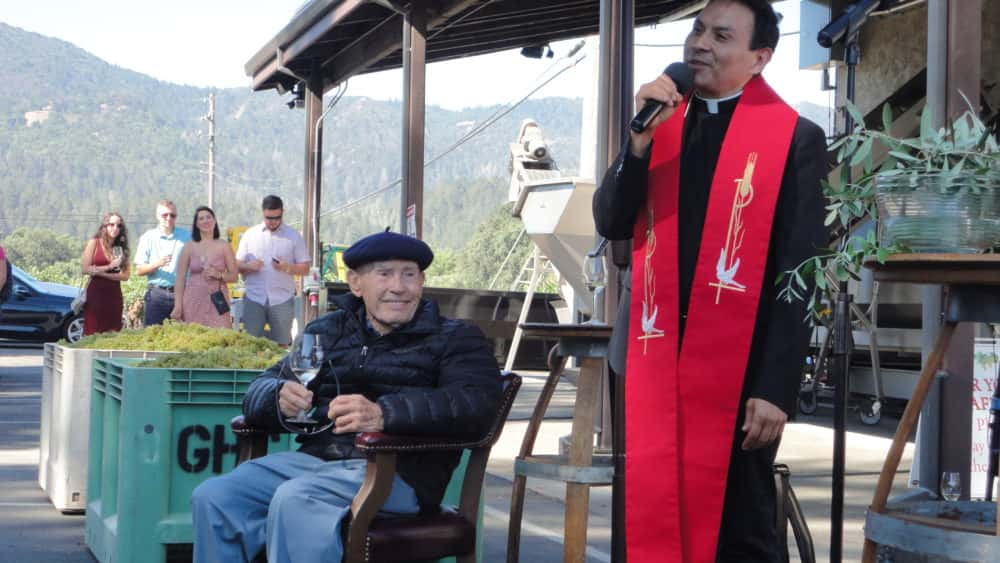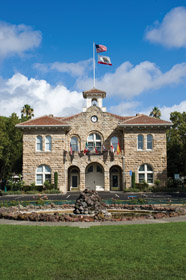So InClined
Cline’s rustic farmhouse and grounds, steeped in California history, sharply contrast Jacuzzi’s classic Italian architecture and familial reverence. What’s more, each has its own fascinating story to tell—but the most fascinating piece might be how they’re connected. Fred Cline and his wife, Nancy, founded both wineries, because like many American families, Cline’s lineage has been blended like a fine wine.
Start at the beginning
In 1907, brothers Rachele, Guiseppe, Valeriano and Francesco Jacuzzi immigrated from Valvasone, a small village in the Fruili region of Italy, to work on the railroads in Washington state. They eventually made their way to Southern California, drawn by the warmer climate and richer opportunities, and were joined by three more brothers, Gelindo, Giocondo and Candido (there were 13 children in all). They all went to work on a local farm, which was owned by a gentleman who was also involved in the early aeronautical industry.
It was serendipitous employment, as eldest brother Raqueli was a natural inventor. Using skills he learned from his woodworking father, he soon developed the “toothpick” propeller, which was less expensive to manufacture than the scimitar-shaped propellers of the time; the toothpick propellor became used extensively on World War I transport planes.

By 1920, the entire Jacuzzi clan (parents Giovanni and Teresa, as well as all remaining siblings and spouses) had relocated to California, and the success and innovations continued. At the Jacuzzi Brothers factory, they developed the first enclosed-cabin monoplane. The family’s work in the aviation field ended when a test flight crashed, taking several lives, including brother Giocondo. His death led to a plea from Giovanni to cease making planes. Valeriano and his wife, Guiseppina, purchased a 161-acre farm in Oakley, Calif., and moved their growing family onto the land, where they planted winegrapes (Zinfandel, Mataro, Carignane and Muscat), as well as other crops.
Jump ahead to 1949, when Mary Jacuzzi (daughter of Valeriano and Guiseppina) married attorney Jim Cline, a union that resulted in nine children. At the age of 13, Fred Cline began learning the family hobby of winemaking from his grandfather, who was a passionate winemaker and passed his enthusiasm to his grandson. In the early 1980s, Cline Cellars was officially founded, using varieties that had been planted by his grandfather Valeriano. “Those varieties thrive on warm days and sandy soil,” says Fred Cline.
Today, the family farms close to 1,000 acres of grapes, including vineyards in and near Oakley, Carneros and the Sonoma Coast.
A historical site
In the late ’80s, Fred and Nancy were living in Martinez, Calif., with Fred driving daily to Oakley and Nancy commuting to Marin County. When she became pregnant with their second child, they decided to find a place to settle down. Little did they know their search would entrench them even more deeply into California history.
In 1989, the couple purchased 350 acres in the as-yet-undefined Carneros AVA; the land had fallen into receivership after its previous owner, restaurateur and equestrian Haden Salt (H. Salt Fish & Chips in San Francisco) had filed bankruptcy. Nancy had grown up in the area and was familiar with the property; she’d boarded her horse there as a high school student. “All I wanted as a child was my own horse ranch,” she says, before teasingly jabbing her husband and adding, “Then Fred bought it and destroyed it to create the winery.”
They both laugh, and their affection and mutual respect is obvious. It’s no wonder they’ve managed to succeed with so many diverse ventures—but more on that as we go along.
The estate dates back to a Miwok encampment and, in 1823, was where the last Spanish mission was dedicated (the actual structure was later built a few miles away in what’s now the town of Sonoma). There’s a cross and small structure on the property, built with authentic adobe brick, to commemorate the site’s importance. The land became part of Mariano Vallejo’s land trust and, in 1851, German entrepreneur Julius Poppe purchased 1,500 acres from the Mexican general. By the time Salt took ownership, it had dwindled to 350 acres.
What’s there now
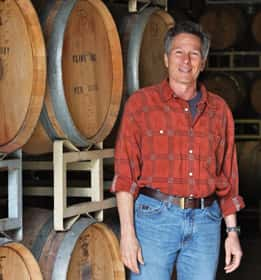 Each previous owner has left a mark on the property. Says Cline and Jacuzzi winemaker Charlie Tsegeletos, “We have relics from the Miwok that were here, and our miniature Sicilian Donkeys [named Fancy and Pudding] are a reminder of the mission padres and how they traveled up and down the state—though they used full-sized animals, of course.”
Each previous owner has left a mark on the property. Says Cline and Jacuzzi winemaker Charlie Tsegeletos, “We have relics from the Miwok that were here, and our miniature Sicilian Donkeys [named Fancy and Pudding] are a reminder of the mission padres and how they traveled up and down the state—though they used full-sized animals, of course.”Poppe may have left the largest legacy. He planted eucalyptus trees, first brought to America by Australians during the gold rush. “They were originally intended for use in building and railroad ties, but when this particular species of eucalyptus dries, you can’t even drive a stake through it [for use in building carriages and railroad ties],” says Tsegeletos. Luckily there’s an upside to these nonnative windbreaks: “The essential oils that come off the leaves have a flavoring effect on the grapes,” the winemaker explains. “We make two wines, Big Break Zin and Small Vine Mouvedre, that have distinct menthol notes. It’s a signature that’s made those wines sought after.”
In addition to the farmhouse (now tasting room) and other structures, “He brought carp fingerling from Holstein, Germany, and introduced the species to America,” says Tsegeletos. There are six natural ponds on the property, including one behind the main farmhouse (now the tasting room), and for $0.25, you can purchase a handful of fish food and watch the feeding frenzy. “These are descendants of the first carp ever brought to America,” Tsegeletos continues. “We have a lot of school kids visit us, and this is one their favorite stops.”
School kids? Turns out, Cline Cellars is a popular educational destination because of its mission connection, which is bolstered by an onsite museum. “In 1939, models of all the California missions were built for the Golden Gate International Exposition on Treasure Island,” explains Theresa Lee, a museum docent who runs class programs when schools visit. “About 18 years ago, Nancy Cline was called to see if she wanted to bid on the Sonoma mission model—she bought the whole collection. Then the Cline family set up a nonprofit foundation to establish this museum. We get thousands of school kids through here very year, from as far away as the South Bay.
The models were commissioned by the state of California and built by German and Italian craftsmen to look as similar to the original missions as possible, based on historic paintings, sketches and photographs. Large color paintings on the wall show the missions as they are now.
Also on the property, you can tour a 1920s era Pullman railcar, view exotic pheasants (and, if you’re lucky, nick a spectacular tail feather from the ground) and, if you’re a wine club member, reserve a picnic table. It’s a family friendly destination that’s available for private events including weddings, corporate functions and special celebrations.
The main attraction
 After an extensive tour of the property, we settle in to taste some wine.
After an extensive tour of the property, we settle in to taste some wine.“Since the winery started in Oakley and we also source from Lodi, we’re able to bring in the right varieties from the right climates,” says Fred. “We’re in a cool region here, and the Sonoma Coast is nice and cool, so that’s where we have efficient users of sunlight—Chardonnay and Pinot Noir, which don’t require as much heat to ripen.”
Also planted in Carneros are Syrah, Nebiolo, Barbera, Sangiovese, Pinot Gris and several Bordeaux varietals. Cline’s 150 planted acres in Oakley plus long-term relationships with growers in that area provide warmer climate fruit. “We were ahead of the curve when it came to planting Italian and Rhone varietals,” Fred continues, adding the he and Nancy were founding members of Rhone Rangers, an organization created to promote that style of winemaking.
The 2014 Pinot Gris sees no oak in fermentation and has ripe, green apple with great acidity and a soft finish. Cline makes this available in kegs (via Free Flow Wines) for hospitality outlets and also custom packages it for the San Francisco Giants’ ballpark. The 2015 Viognier is a beautiful alternative to Chardonnay—pear and apricot on the nose with a refreshing body and finish. “It’s a rare bird,” says Tsegeletos. “There are only 3,000 acres total planted to the variety in California.” He uses a unique block of Sonoma Carneros grapes and a different technique to create a Pinto Grigio for Jacuzzi Winery.
As Tsegeletos predicted, a 2013 Grenache from the Big Break Vineyard has a faint but distinct eucalyptus element on the nose. It’s lush and rich, with plum and blackberry. “This goes well with lamb,” Tsegeletos offers.
A 2014 Sonoma County Syrah, made completely with cool-climate fruit, is peppery, which Tsegeletos attributes to its Sonoma County terroir. We try a few other varietals, some familiar and some not-so-much, and they’re all delicious. “We want each of our wines to be smooth [when released], but still with enough tannin that they have backbone,” says Tesgoletos.
“We believe in over-delivering in terms of price for value, with a commitment to family, pride and authenticity.”
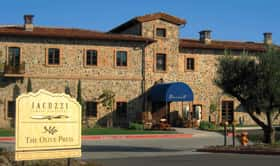 Cross the road
Cross the road
A few days later, I return to the area to learn more about the Jacuzzi side of the road. Gone are references to California’s rich history and instead we’re greeted with Italian hospitality. The building is modeled after the Jacuzzi family home in Italy, complete with a central piazza that opens to the back and overlooks some of the family’s vineyards. Out front is a giant millstone, once used to produce olive oil, and an outdated grape press. Roof tiles were imported from Italy and a large chandelier in the entryway was commissioned (and hand-blown) on the island of Morano.
“I learned winemaking form my Italian family,” says Fred Cline, “and I wanted to recreate an Italian family winery here.”
A tour takes us upstairs, where a small museum is dedicated to the brothers’ ongoing ingenuity (See “As in ‘Jacuzzi’?” below), including photographs, documents and early iteration devices. Back on ground level, we stroll through a courtyard with Neptune’s Fountain—a popular wedding spot, our host tells us—as we sip Prosecco and learn about Nancy Cline’s talent for finding unique, appropriate and often unexpected pieces of art to compliment both winery sites. (Remember the mission models? That’s just the beginning.) She found Neptune, for example, in a warehouse in Verona.
In the barrel room, one wall is adorned with a large triptych of St. Teresa of Avilla, which Nancy found in France and had shipped over. The room’s grandiose entrance—a Carrera marble depiction of Bacchus and a loving female disciple, partaking of wine under a canopy of grapes—was bought from a bust dot-commer, who’d commissioned the piece for his private home before the industry crashed. We pass under the wine god’s watchful gaze as we head to the piazza for a tasting.
Salute!
Jacuzzi bottles 24 different wines, primarily made from Italian varieties that Fred Cline planted beginning in 1994 and 1995. Many are rare or even unique across Northern California.
There’s the 2015 Gilia, named for a younger Jacuzzi sister and made from the Vernaccia grape. It’s an unusual variety, we’re told: light and summery, similar to Sauvignon Blanc but not grassy. The 2014 Arneis (which translates to “little rascal,” so named because of the grapes temperamental growing qualities) is a refreshing, medium-bodied white wine, with mandarin orange on the nose and palate. A 2015 Rosé of Sangiovese had a lovely ruby color and tasted like a cherry cordial.
Next, we sampled the 2014 Sangiovese, this time in its full-red state. Ripe fruit and light tannins, this is definitely a food wine. Likewise, the 2012 Aglianico calls out for hearty winter fare; its berry nose and earthy, mushroom and coffee notes have me wishing for rainy nights and red sauce.
Other standouts include 2014 Primitivo (comparable to Zinfandel), which is spicy and robust; the 2014 Montepulciano, which displays blueberries and violets, soft tannins and lovely caramel notes; and the 2013 Valeriano, a red blend named for Fred Cline’s maternal grandfather, which has vanilla cream soda on the nose, chewy texture and well-rounded flavors.
It’s a real treat to try so many unfamiliar wines in a setting that offers guidance and education. “We make a lot of wine,” says Fred. “Having the two wineries is a way to differentiate and lets people taste things might not try otherwise.”
Press on
Also housed within the Jacuzzi estate is the Olive Press, located across the entryway from the winery’s tasting room. Founded by Ed Stohlman in 1995, the business was originally located at the Old Mill Building in Glen Ellen. “He loved Italy and was one of the first to make olive oil in California,” says Fred. “He brought in Italian olives, but he also opened it as a cooperative for locals who had olive trees and wanted to press oil. We’d all bring our olives in and he’d press a communal oil that was distributed back by percentage.”
The Clines started as members and soon became friends, so when Stohlman came to them a few years later with news he needed to move the business, the Clines offered space at Jacuzzi. When Stohlman passed in 2012 at age 86, the Cline’s assumed control of the business. “He wanted us to run it,” says Fred. Stohlman’s photo is prominent at the entrance to the Olive Press tasting room at Jacuzzi. It still offers a communal press for locals, and it’s expanded its product line to include many award-winning oils.
The room is busy, offering samples of manydifferent styles and flavors of its olive oil, as well as selling cookbooks, oil dispensers and dipping trays, culinary accessories and fun pieces. Hosts can guide a tasting much like wine to showcase the subtleties in each different oil, teaching nuances between olive varieties, speaking to the influence of terroir and explain how various herb essences are infused—to delicious result.
Projects of passion
Fred and Nancy Cline have delved into myriad ventures with enthusiasm and dedication, bringing each one to fruition by working hard—and working together. “We get excited about things and want to pass that along,” says Nancy.
She continues, “It’s all so fun! We’re passionate about every one of our projects—we have an abundance of passion.”
As in “Jacuzzi”?
Although they stayed away from aviation following their father’s plea, Valeriano’s siblings continued to innovate and create. They transferred their knowledge of propeller technology to the ground, developing Frost de fugo (a frost prevention fan for agriculture), among others. But it was their submersible pump, the first in the world, which pulled water from the ground, that was the first step toward their most famous invention.
Winemaker Charlie Tsesgoletos tells the story: “Fred Cline’s cousin, Kenney, son of one of the younger Jacuzzi brothers, developed rheumatoid arthritis when he was a child. They had no antibiotics and he became handicapped after having strep throat and developing rheumatic fever. They had to take him for hot water treatments at the hospital often.
“The [boys] were making water pumps already, so Mother Jacuzzi said, ‘Make something for him so he can stay home. So we don’t have to travel all the time to help him.’”
In an effort to reduce the pain associated with this child’s affliction, the Jacuzzi brothers used their knowledge of hydraulics to create a hydrotherapy pump, the J-300. This pump was portable and transformed any standard bathtub into a rejuvenating spa, launching the wellness industry. In 1968, Roy Jacuzzi created the integrated whirlpool bath, featuring integrated jets with a 50-50 air-to-water ratio. This jetted bathtub eventually led the way to the indoor-outdoor hot tub that bears the family name.
The Green String Connection
“We farm organically. We’re Green String certified,” says winemaker Charlie Tesgoletos, referring to the natural farming practices developed by Bob Cannard, “a pioneer in the natural process farming movement in California.”
He continues, “We have sheep and goats we use for weed control a few times per year, and we also use weed-whackers to avoid having to spray. Some of what we’re doing is close to biodynamic. Bob and Fred [Cline] have worked out the farming routine here—no herbicides or pesticides, we don’t do much in the way of fertilizing, we use fish emulsion and we compost grape skins, seeds, peduncles, pulp and must.”
Fred Cline helped Cannard found Green String Farm and Green String Institute in 2003 as a way to train the next generation of farmers. Students of all ages and from all corners of the world learn about organic, nonintervention farming—everything from growing and harvesting to butchering and animal husbandry. It’s a communal living environment, with lectures, teaching, wood and metal working in addition to chores around the property.
“We try to use or reuse natural products from the area when we can,” says Cline. The tasting bar at Jacuzzi used fallen Sonoma Valley wood, as did tabletops at Dillon Beach Resort (another Cline family venture).
For more information about Green String Farm, see “The New Pioneers,” July 2016.
Hospitality Ventures
The Cline family has, over the years, expanded its ventures to include a few nonagricultural enterprises. Each came from a chance encounter or conversation and led to new adventures—something Fred and Nancy have affably accepted time and time again. “We follow our emotional path,” affirms Nancy. “Even if it’s going to get tough, we keep going.”
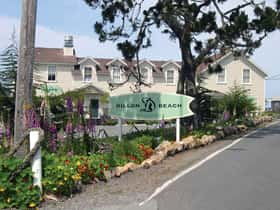
Dillon Beach Resort
In the mid 1990s, Fred and Nancy discovered Dillon Beach Resort (on the north side of Tomales Bay), one of the last privately owned beaches in northern California, and loved it. “Being parents of small children, it felt very safe,” says Nancy. “The bathrooms at the beach were clean and there was limited access, which we felt was a plus.”
The couple had been looking for a small weekend getaway for some time when, in 2000, they heard of a house available in the area and went to take a look. “The whole place was for sale,” says Nancy, “so to get the house [we were interested in], we needed to buy the resort.”
It took some work, inside and out, but now it’s a charming, pet- and family-friendly destination for surfing, swimming, sunbathing and just gazing into the beautiful Pacific, with three ocean-view cabins, a cafe, surf shop and general store. “We still love it today,” says Nancy.
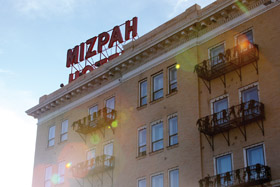 Mizpah Hotel
Mizpah Hotel
Located halfway between Reno and Las Vegas, Nancy Cline’s great uncle and grandmother came to Tonopah, Nev., during the gold/silver mine boom. “It’s in the middle of the high dessert—really in the middle of nowhere,” she says.
“In 2005, I received a call from a realtor in the area asking if I wanted to buy the Mizpah Hotel in town,” she continues. “It was in disrepair but still had all its original fixtures—lights, brass knobs, the original safe. It had the potential to be magnificent.”
The Clines renovated the hotel (it reopened in August 2011) and, in doing so, says Nancy, “We really brought back the center of town. The lobby has become a gathering place for events and local information. It’s like a step back in history.”
They’ve since opened Tonopah Brewing Company next door, which operates as an event center and entertainment venue for locals and visitors alike, and their son, Ramsey Cline, opened the Mizpah Club in 2006.
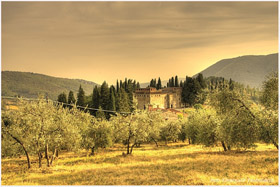 Villa Laura
Villa Laura
As work in Tonopah was getting underway, the Clines moved to Italy for a year. It had been in the plan before the Mizpah opportunity and they decided to follow through. While in Tuscany, they stumbled upon Villa Laura which, in 2003, was the setting for the film Under the Tuscan Sun. Like Mizpah, the property and building were in need of some TLC. The family purchased and lovingly restored it, and it’s now available as a historic and serene vacation property.
“We lead a serendipitous, magical life,” says Nancy as she reflects on the twists and turns she and Fred have taken together.
After establishing a base in Italy, the Clines began importing wines from there. They found a few small producers with similar traditions and a compatible belief in hospitality and natural farming. “We helped them navigate wholesale channels and bring their wine here,” says Fred.



